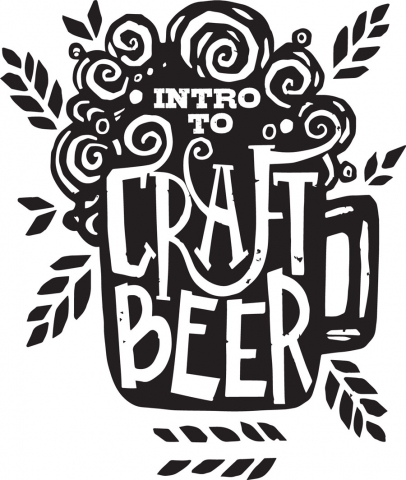Intro to Craft Beer
So, You like beer. That’s good. You probably know at least a little about beer. That’s better. Maybe you’d like to know more about beer. Or perhaps you know almost nothing about beer, and would like to know where to start. That’s the best.
Beer is old. Older than you think. Older than almost every civilization you’ve ever heard of (Fn. The oldest known beer dates to Iran circa ~7000 years ago). Older than money. Older than written language. Beer has staying power. In fact, someone probably wrote an article like this about beer a thousand years ago. Except that article was probably better than this one.
Why are we still obsessed with beer? Because beer is good. Beer is great. In fact, per a founding father, beer is: “proof that God loves us and wants us to be happy.” [Fn. Ben Franklin possibly never said this, but he MAY have, and it’s a great quote nonetheless.]
This issue is about craft beer. What is craft beer you ask? Craft beer is to mass market beer as a homemade chocolate chip cookie is to a Chips Ahoy![tm]. Craft beer is a chef’s masterpiece vs. a TV dinner. In fact, if you prefer a Bud, etc., stop reading this and go drink in the convenience store parking lot.
Craft beer is a local phenomenon. Craft beer celebrates the micro rather than the macro. Local things make beer taste unique. For example, the minerals in local water interact with the yeast, hops, and malted barley to produce a beer which couldn’t be made anywhere else.
So where to start? Since we don’t have all day, we will start with the Genesis of modern beer [fn. The Germans get the initial props, but since this is not a book, we will gloss over many German-style craft beer styles, of which there are a great many]. Germans are known for making things with quality and precision. Beer is not an exception. While many cultures historically made beer, the Germans were the first to legislate its production.
The Reinheitsgebot (German beer purity law) dates from circa ~1500 A.D. This law sought to control the composition of beer, and limited beer ingredients to water, barley and hops. Why no yeast you ask? At the time of the initial law, the existence of yeast was unknown, and brewers relied on natural yeast in the air to create the fermentation (this last part is critical to the evolution of local beer styles.) Since the Reinheitsgebot, beer has generally been made with these ingredients. Some variations have occurred, as described later in this article.
To understand beer, one needs to understand how the ingredients of beer come together to make the finished product. The first ingredient is malted barley. Barley is a grain (like wheat) and is typically sold in kernel form (again, like wheat.)
The process of malting is simply germinating the barley by soaking it in water to encourage sprouting, then stopping the germination by drying the sprouted barley. The malting process allows the enzymes in the barley to turn the barley starch into sugar. Once the grains are dried, they are then roasted. Generally, the darker the roast, the darker the beer.
Once the barley is turned into malt, the malt is steeped in warm water to create a sugary liquid called wort. We are again skipping over numerous techniques and differences (many beer types differ only in the style, roast, or type of malt) to arrive at a manageable description of the process.
The wort is then typically boiled with hops. Hops are a flower of a climbing vine. Hops are very bitter, and contain, among other things, alpha acids, which give beer the characteristic bitter taste.
When the wort has been boiled with the hops, the yeast is then “pitched” into the warm, bitter, and sugary liquid. The yeast (tiny, single- celled microorganisms in the fungi kingdom) then start to eat the sugar in the liquid. Through bio-chemical processes, the yeast turn the sugar in the wort into alcohol and carbon dioxide. Not all of the sugars are transformed, but most are. This is usually why some beers are sweeter than others: the yeast complete the fermentation cycle more completely in some beers.
Briefly, the yeast is of generally two types: lager yeast or ale yeast. Lager yeast is a bottom-fermenting yeast. In other words, the yeast stay at the bottom of the fermentation vessel. Ale yeast, on the other hand, is a top-fermenting yeast. The ale yeast stay on the top of the fermentation vessel. Generally, the lager yeast like a colder temperature, and the ale yeast like a warmer temperature. The warmer temperature generally results in more pronounced, caramel-like flavor.
Once fermentation is complete, the beer is typically filtered and transferred to another vessel for a secondary fermentation. Following this, the beer is then often carbonated via artificial means and bottled, kegged, or canned. Sometimes, natural carbonation is used, which involves adding a little extra sugar to the bottle or can, and letting the residual yeast make a little more carbon dioxide.
This article will attempt to describe and discuss the various craft beer styles you may encounter. In the interest of clarity and experience, we will discuss the lighter beer styles first and move on to the heavier (fuller-bodied) styles later. It is impossible to cover all of the craft beer styles in brief, so we will focus on the most common types.
First up: the Germans again. Forget what I just told you about the Reinheitsgebot. The Germans, having created the first beer law, promptly decided to break it. They used wheat instead of barley (the malting process is very similar) and a funky yeast that creates a beer that tastes somewhat like banana bread. The “Hefe” is the yeast, while the “weizen” is the wheat. A true German Hefeweizen is a light ale with a distinct banana flavor.
The Germans and Czechs also make a beer style called, generically, a lager, or sometimes a Pilsner [fn. A type of lager which originated in what is now the Czech Republic]. This style is characterized by a lighter malt (less roasting) and a lager yeast. Lagers are usually a little hoppier than many beers. Most lagers are brewed and stored cold. American mass-market beers are a sad analog of traditional lager or Pilsner style beers. Many mass-market American lagers use cheaper adjuncts (rice, sugar, etc.) to replace some of the barley.
Moving from the European mainland to England, we encounter the venerable pale ale. Most American craft beers are descendants of this style. While innumerable beer variants exist, in the craft beer world, the pale ale is king. Pale ales were traditionally made with a lightly-roasted malt, and were moderately hopped. The characteristic English style is a mild, balanced ale, with a medium alcohol content. Popular American craft beers tend to tweak the standards, usually by using a more aggressive hops or a darker roasted malt.
The pale ale spawned a mutant child in the India Pale Ale (IPA). IPA’s are like pale ales on steroids. Everything about them is more extreme. They are maltier, hoppier, and have more alcohol. There is an oft-repeated story that the long ocean voyage (from England to India) necessary to supply the British troops with beer on the sub-continent, required the beer to be stronger in every way to prevent spoilage. It is unclear if this was the reason for the stronger beer, but there is no question the style started out as a more intense version of a pale ale, and has persisted to this day. The IPA is usually the rock-star beer of a brewery. In all honesty, this is for good reason: if you can make a great IPA, you can probably make any beer well.
We will also briefly discuss other, darker English beer styles. Those styles are porter and stout (historically, “stout-porter”.) A porter is the darker, more handsome cousin of the pale ale. It has more malt, more hops, and more alcohol. The difference between a porter and an IPA is that the malt used in a porter is usually more heavily roasted, and the hops are not as prevalent. Porters are strong, but usually more malty and darker than IPA’s.
A stout is a porter that has turned to the dark side. Stouts employ the darkest roasted malt and a great deal of hops to balance all that malt. Stouts are “stout” in every sense of the word. In the English beer lexicon, stouts were the king of the castle. They were the most expensive beers to make, and delivered the heftiest punch.
As an aside, one cannot discuss stouts without discussing the Irish Dry Stout style. Irish stouts are not really at all like English stouts. Because of export restrictions many years ago, the Irish did not get malt of the quantity and character necessary to make a traditional English stout. As a result, the Irish heavily roasted the malt they had, and used more hops. While Irish stouts look dark, because of the lower initial malt content, they are actually light-bodied, and much lower in alcohol than a regular stout. In the northern part of Ireland (e.g. Dublin), Guinness is the leader, while southern Ireland (Cork and surrounding areas) prefers Murphy’s. These beers are very similar, although Guinness purportedly contains a small amount of lactobacillus bacteria (included as part of the brewing process) which gives it the characteristic sour twang.
Besides the above styles, many other craft beer types are popular in Oklahoma City. You can investigate for yourselves the more esoteric (Belgian) styles, such as the lambics, the goses, or the sour browns. This issue highlights many excellent local spots to sample craft beer.






